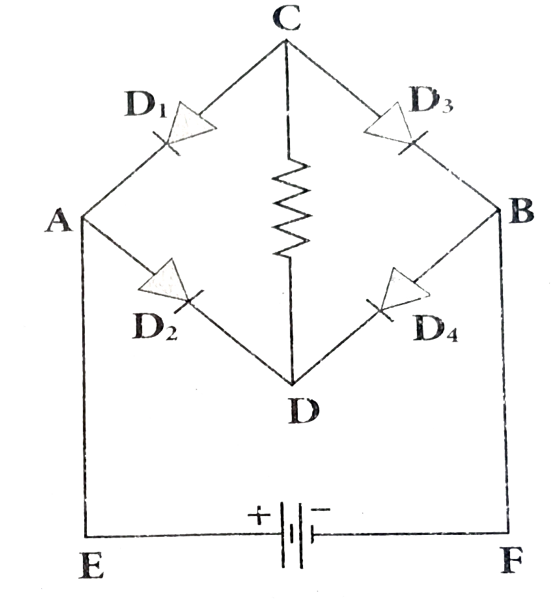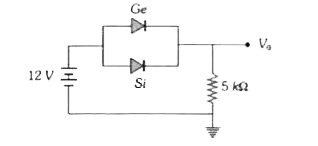Two junction diodes, one of germanium (Ge) and other of silicon (Si) are connected as shown in fig to a battery of 12V and a load resistance 10kΩ. The germanium diode conducts at 0.3V and silicon diode at 0.7V. When current flows in the circuit, the potential of terminal Y will be
(##AKS_NEO_CAO_PHY_XII_V02_C_C06_SLV_013_Q01.png" width="80%">
The Ge diode conducts for a p.d of 0.3V, therefore the current passes through it and the Si diode do not conduct. Hence the potential of terminal Y = 12-0.3 = 11.7V
Topper's Solved these Questions
- SEMICONDUCTOR DEVICESBOOK - AAKASH SERIESCHAPTER - SEMICONDUCTOR DEVICESEXERCISE - EXERCISE -I (ENERGY BANDS AND CLASSIFICATION OF SOLIDS )
43 Videos
- SEMICONDUCTOR DEVICESBOOK - AAKASH SERIESCHAPTER - SEMICONDUCTOR DEVICESEXERCISE - EXERCISE -I (P-N JUNCTION DIODE)
35 Videos
- SEMICONDUCTOR DEVICESBOOK - AAKASH SERIESCHAPTER - SEMICONDUCTOR DEVICESEXERCISE - Problems (LEVEL-II)
7 Videos
- RAY OPTICSBOOK - AAKASH SERIESCHAPTER - RAY OPTICSEXERCISE - PROBLEMS ( LEVEL-II)
50 Videos
- UNITS AND MEASUREMENTBOOK - AAKASH SERIESCHAPTER - UNITS AND MEASUREMENTEXERCISE - PRACTICE EXERCISE
45 Videos
Similar Questions
Carbon, silicon and germanium have four valence electrons each. These are characterised by valence and conduction bands separated by energy band gap respectively equal to (Eg)c,(Eg)Si and (Eg)Ge .Which of the following statements is true ?
(a) (Eg)Si<(Eg)Ge<(Eg)C
(b) (Eg)C<(Eg)Ge>(Eg)Si
(c ) (Eg)C>(Eg)SI>(Eg)Ge
(d) (Eg)C=(Eg)Si=(Eg)Ge
View SolutionThe neutral region formed at P-n junction due to recombination of electrons and holes is
View SolutionA n-type silicon sample of width 4×10−3m, thickness 25×10−5m and length 6×10−2m carries a current of 4.8 mA when the voltage is applied across the length of the sample. If the free electron density is 1022m−3, then find how much time does it take for the electrons to travel the full length of the sample? Given that charge on an electron e=1.6×10−19C
View SolutionTwo plane mirrors are combined to each other such that one is in y-z plane and the other is in X-z plane. A ray of light travelling along a vector ˆi+ˆi+ˆk is incident on the first mirror. Find the unit vector in the direction of emergent ray after successive reflections through both the mirrors.
View SolutionThe ratio of S.I. unit of universal gravitational constant to C.G.S. unit is
View SolutionThe diode shown in the circuit is a silicon diode. The potential difference between the points A and B will be

View SolutionCalculate the value of output voltage V0 (in V) if the Si diode and Ge diode conduct at 0.7V and 0.3V respectively. Fig.

View SolutionSilicon and Germanium p-n junction diodes are not used for making LEDs
View SolutionTwo junction diodes, one of germanium (Ge) and other of silicon (Si) are connected as shown in fig to a battery of 12 V and a load resistance 10 kOmega . The germanium diode conducts at 0.3 V and silicon diode at 0.7 V . When current flows in the circuit, the potential of terminal Y will be .
View SolutionAssuming that the silicon diode (having negligible resistance) the current through the diode is (knee voltage of silicon diode is 0.7V )
View SolutionWhy is a silicon diode better than a germanium diode in a rectifier circuit?
View SolutionTwo junction diodes one of germanium (Ge) and other of silicon (Si) are connected as shown in fig to a battery of e.m.f. 12 V and a load resistance 10kOmega The germanium diode conducts at 0.3V and silicon diode at 0.7 V When a current flows in the circuit , the potential of terminal Y will be :
View SolutionFour silicon diodes and a 10 Ω resistor are connected as shown in figure below .Each diode has a resistence of 1Ω Find the current flows through the 10 Ω.

View Solutionएक सिलिकॉन डायोड परिपथ चित्र में दिखाया गया है। बिन्दु A एवं B के बीच विभवान्तर होगा

View Solutionजर्मेनियम डायोड एवं सिलिकॉन डायोड क्रमशः 0.3 V एवं 0.7V वोल्ट पर चालन करते हैं। दिये गये चित्र में यदि जर्मेनियम डायोड के कनेक्शन परिवर्तित कर दिये जायें तब V0 के मान में कितना परिवर्तन होगा

View Solution
